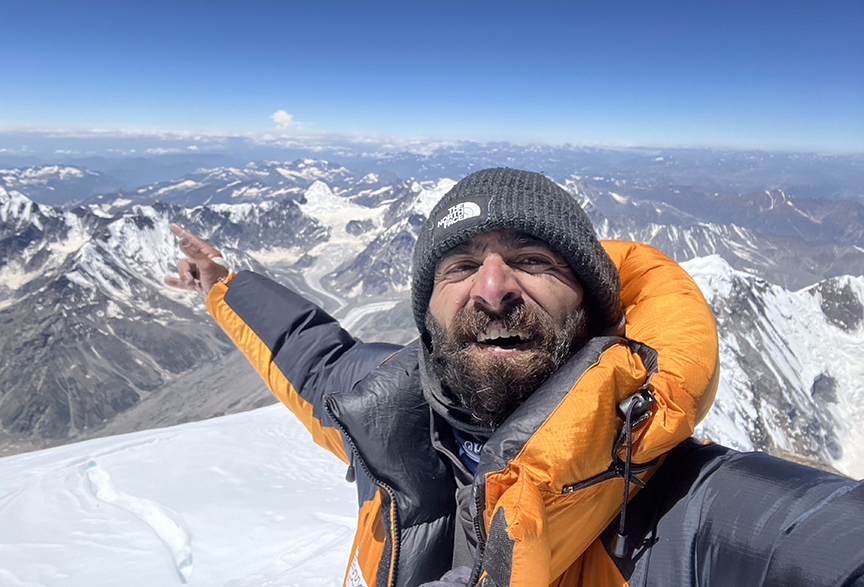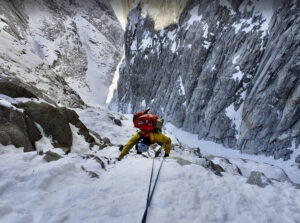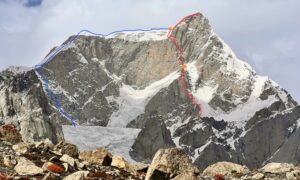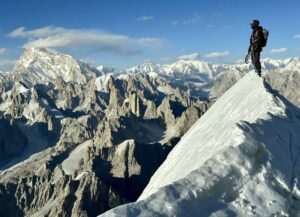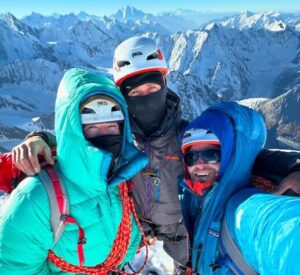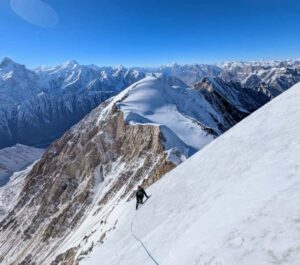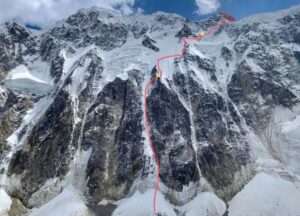Among the climbers on Pakistan’s 8,000m peaks this season, only one climbed two of them — Nanga Parbat and K2 — without bottled oxygen: Sohail Sakhi from the Hunza Valley.
We spoke to Sakhi and discovered an impressive character: a college-educated mathematician who heard the call of the mountains.
A man of numbers in a land of mountains
Sakhi comes from a part of Pakistan where most men try to make a living by working for mountaineering expeditions. But Sakhi’s path was different. While studying pure math at university, Sakhi “realized my calling was in the mountains…the commonality between the mountains and pure math is that everything is abstract.”
He began to spend his free time trekking and decided that this was what he wanted to do with his life. He started guiding and never stopped.
“It is not just a job for me, but a way of staying connected to my homeland. I have extensive experience guiding all over Pakistan, in every province and every mountain range,” he said.
Sohail Sakhi on the summit of K2, August 11. Photo: Sohail Sakhi
“After working for several years, I was able to acquire my own [camera] and continue to develop my skills,” he said. “I have now been a mountain photographer for several years and have expanded to drone piloting as well.”
The biggest change in Sakhi’s career came this year, when he founded Moving Mountains, his own outfitting company that hires people from his community.
“For too long, many companies have been promising change [but there have been] no increases in wages for local guides or porters and increasingly poor working conditions,” he explained.
Nanga Parbat and K2
On his own climbs, Sakhi advocates foregoing bottled oxygen.
“I do it to push my limits in the mountains and connect in a spiritual way that I believe is only possible like this,” he said.
On his first K2 assignment, he was ordered to use supplemental oxygen for safety, but this year, he could make his own choice and finally climb without gas.
Sakhi planned for Nanga Parbat this year, not as a worker for a foreign company, but as the leader of a group of six young climbers from his hometown.
“The plan was to expose them to commercial climbing and larger expeditions. Meanwhile, I planned to climb with no O2,” he said.
Sakhi had previously helped fix the ropes on Nanga in 2024, but another work commitment forced him to abandon the mountain before there was a summit chance.
Views from Camp 2 on K2. Photo: Sohail Sakhi
In 2025, the main problem for Sakhi’s team was a lack of funds.
“We were ready to eat noodles the whole time,” he said. “Our community came together and supported us where they could, including previous clients of mine, but it was very difficult to find larger sponsors.”
Climbing with humble means, two of his team reached the summit: one with oxygen (Sezad Karim) and Sakhi with no O2 and no porter. The expedition was a success, and even those who didn’t summit learned from the experience.
Then came another challenge: In the age of ultra-luxurious expeditions, Sakhi wanted to climb K2 without oxygen and on a shoestring budget. Here’s how Sakhi did it:
On K2, I wanted to evaluate my health and condition after Nanga…Luckily, I was healthy and ready to follow through on my plan to summit K2 without O2 and without a porter. It took me three days to arrange logistics to support my climb, and then I began the trek to K2 base camp.
The rest of my Nanga team had returned home due to insufficient funds. I was able to arrange free food for myself at Base Camp and had the assistance of one porter from Askole to carry my belongings to Base Camp. While other teams had large setups, I had my own camp with my trusty MSR three-season tent and donated equipment. Without sponsors, we have learned to make do with what we have.
Sakhi found an extra source of income by joining the rope-fixing team, thanks to Mingma G, whom Sakhi had met on K2 in 2022.
Risks, danger, and death
The 2025 season featured bad conditions and rockfall risks, which took three lives. However, Sakhi’s experience taught him a lesson: K2 is always dangerous.
“When I climbed K2 in 2022, three climbers lost their lives when the conditions were close to perfect with record summits. Yet still several climbers died,” he explained. “When we step into the mountains, there is a certain level of risk we all understand and undertake, and I am acutely aware of the risks involved.”
Sakhi was a friend of Iftikhar Hussain, killed in a snow and rock avalanche in July, and helped to bring his body down. He also helped down an injured mountain guide.
Dry, dangerous conditions on K2 this year. Photo: Sohail Sakhi
“Rockfall this year until Camp 2 was not ideal, but above Camp 2, the snow conditions were nearly perfect,” Sakhi continued. “Mingma G and I left later than all the clients to test the rockfall risk below Camp 2 and ensure we could be as safe as possible.”
Sakhi also mentions a crucial factor in explaining what happened during the summit push this year: “When we climbed up to Camp 1, there was nearly zero rockfall after 4 pm on the summit push.”
Conditions on the descent were apparently much worse.
Left behind
In the future, Sakhi hopes his company can prosper and help solve what he considers an unfair trend.
“Nepalese companies and Western companies have grown exponentially in the past several years across Pakistani mountains, but it is not about just their growth,” Sakhi claims. “It is about how, as they have grown, the Pakistani climbing community has mostly been left behind.
“When we try to grow and reach out to the press, [our messages] often receive no reply or we are told that it is up to Pakistan to build everything themselves. [Pakistan] is often written about negatively.”
A climbing wall in Hunza, a recent improvement. Photo: Sohail Sakhi
Sakhi listed some of the problems that affect local companies and communities, preventing them from growing at the same pace as the industry:
- Most of the community belongs to remote mountain villages that have lacked communication infrastructure, access to advanced education, and funds for high mountain gear.
- In the past, there have been no climbing schools, no climbing walls, and no concept of the mountains as a sustainable career path. While Western companies have often come and used Pakistani porters, they are mostly left behind on summit pushes. Pakistanis are not thought of as full mountain guides.
- A Pakistani HAP is typically paid $2,000-3,000 for a full expedition. A Sherpa’s payment and cost to bring them to Pakistan for an expedition is between $15,000-20,000. Meanwhile, a Western mountain guide is paid $20,000-30,000 to come to mountains they have often never explored before. With the amount of money being paid to a Pakistani HAP, there is no way they can afford proper mountain gear. A summit suit and boots alone are more than the wages for one season. Although companies promise to provide the necessary gear, in reality, this does not happen.
A question of life and death
Sakhi explained that, much like Nepal’s Sherpas, most Pakistanis working in the mountains come from remote mountain communities more than 2,000m above sea level.
“They are very strong physically and have an even stronger will, because for many, this work is a life-or-death situation to support their families,” Sakhi said. “The more opportunities provided to them, the more the world will see that we are just as qualified as Nepalese and Western guides. Moving Mountains is working to solve this problem: We ensure our certified guides are fluent in English and have extensive experience in the mountains, including proper gear.”
At the local climbing wall in Hunza, teaching boys and girls. Photo: Sohail Sakhi
Sakhi pointed to a local yet significant improvement in his hometown.
“This year, we have built a proper climbing wall in Hunza for the first time, to train the young people on proper technique and expose them to opportunities in the mountains.” Significantly, he assured us that they are working with both boys and girls.
Room for all, with regulations
Sakhi was critical of independent climbers when asked about this season on K2.
“Independent climbers rely solely on commercial teams’ plans without offering any support to bring ropes or assist in any way,” Sakhi said. “We were repeatedly asked what our plans were, and when asked the same, they would tell us they had none and were waiting on our pushes.”
However, when asked if he believes there is still room for everyone on the normal routes of Pakistani 8,000’ers, he said yes, with some conditions. Sakhi believes the issue must be regulated and paid for.
“We need a central system to ensure that anyone who makes it to Base Camp with the intent to climb pays into a fund to fix the ropes and understands that there will then be a team to do so,” he said.
Keep rookies away
He also wants a dedicated rescue team in place that supports commercial expeditions and independent climbers, and is funded by both.
“For instance, there was a situation this year where we had to rescue an independent Western climber who had been coming to these mountains for many years,” Sakhi noted. “Unfortunately, he did not express any appreciation for the rescue we performed or provide any financial support. He complained that no one had informed him of the rope situation, and he was climbing alone, fully responsible for himself, but expecting updates and assistance from other climbers and expeditions. This work should be systematized to prevent further incidents like this.”
Camp 2 on K2. Photo: Sohail Sakhi
Sakhi also thinks Pakistan should require climbers to have previous experience and skills. “More and more, less experienced climbers come to the mountains,” he recalled. “This year, there was a young climber who spent 45 days at Base Camp and only made it to Camp 1.”
Sakhi also mentioned several other climbers in the same situation, with little mountain experience but extensive publicity.
“They not only put themselves at risk if they go higher, but everyone else on the mountain as well. Should this be allowed? Or should we ensure that those who enter the big mountains have experience to not only be guided up a mountain, but also save themselves in case of an emergency? With this, why is the press focused on climbers who are increasingly becoming ‘influencers’ rather than pure climbers, and not giving exposure to local climbers with years of experience?”
Karakoram experience required
Sakhi also criticized Western guides at the head of trekking groups.
“Many Western companies bring trip leaders to the K2 Base Camp and Gondogoro La Trek from abroad who have no experience in the Karakoram and no stamina to take clients safely and successfully to the finish.”
He claims he has heard complaints from foreign trekkers about trip leaders not qualified for the Karakoram.
“The Karakoram is not like Nepal. We have no infrastructure, and rescue is often very expensive and nearly impossible. I have seen Western clients die in front of my eyes in easily preventable circumstances, not just on mountain expeditions, but on treks.”
